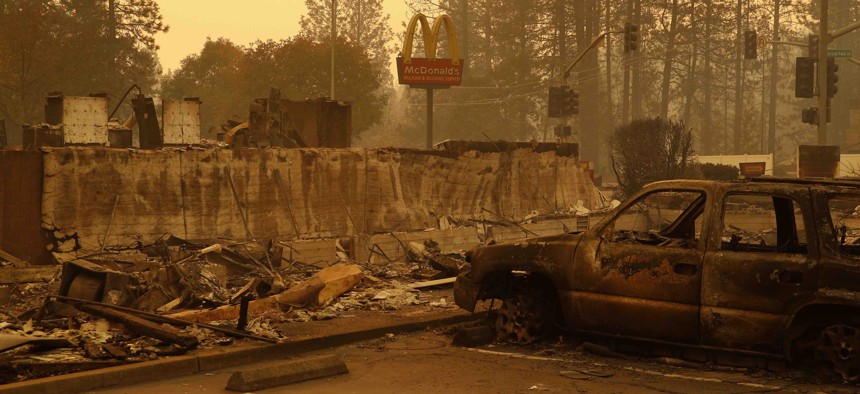Poor and Minorities Face Outsized Wildfire Vulnerabilities, Study Finds

A sign still stands at a McDonald's restaurant burned in the Camp Fire, Monday, Nov. 12, 2018, in the northern California town of Paradise. AP Photo/John Locher
The analysis looks at both fire hazards and "adaptive capacity" in communities around the U.S.
The catastrophic blazes that continued to burn in California on Monday underscore grimly the threats that communities across the West, and in other parts of the U.S., face from wildfire.
About 29 million Americans, roughly 9 percent of the nation’s population, live in areas that have at least a moderate potential for high-intensity wildfires, according to an article published in the peer-reviewed journal PLOS ONE earlier this month.
A majority of these people are white and socioeconomically secure, note the authors—a University of Washington graduate student and researchers with The Nature Conservancy.
But the researchers also find that about 12 million people are “socially vulnerable.” Additionally, they conclude that vulnerability to wildfire is unequal across racial and ethnic groups, and rises with the proportion of black, Native American, or Hispanic residents in an area.
“While fire-prone places in the U.S. are more likely to be populated by higher-income groups, this fact threatens to overshadow the thousands of low-income individuals who also live in fire-prone places but lack the resources to prepare or recover from fire,” they write.
“In California,” they add, "many individuals in rural areas, low-income neighborhoods, and immigrant communities do not have access to the resources necessary to pay for insurance, rebuilding, or continual investment in fire safety, thereby increasing their vulnerability.”
The article suggests that by better understanding who is most vulnerable to wildfire, and why, policymakers will be able to look at “socioeconomic and political solutions” to curb risks.
To conduct the study, the researchers looked at both exposure to fire hazards and “adaptive capacity” across census tracts. Adaptive capacity here refers to the ability of the tract to “absorb and adjust” to wildfire, while minimizing damage to life, property and services.
In considering adaptive capacity, the authors use an index based on 13 factors within the census tracts, such as the number of people who are below the poverty level, don’t have vehicles, live in mobile homes, or are 65 years-old or older.
By looking at fire through this lens, they find, for example, that some areas with moderate fire hazard risks, like regions in the southeastern U.S., have a high level of vulnerability when considering socio-economic variables. Likewise, they say poorer communities in California’s Sierra Nevada mountain range are especially vulnerable to fire disasters.
The article says that while black residents tend to not live in the areas with the highest wildfire hazards, they are overrepresented in communities that are somewhat prone to wildfire but that would likely not respond or adapt well if a fire were to occur.
It adds that Native Americans are highly overrepresented in all of the most vulnerable areas in the study.
The extreme hardship fire survivors can face is evident in California, where the Camp Fire drove upwards of 50,000 people in Butte County into some form of homelessness, as Capital Public Radio reported.
By Monday, that fire had destroyed about 11,700 residences and had killed at least 77 people, in the town of Paradise and other areas east of Chico, according to Cal Fire.
Hundreds of miles to the south, northwest of Los Angeles, the agency said Monday that the Woolsey Fire had burned at least 1,500 structures and had claimed at least three lives.
Bill Lucia is a Senior Reporter for Government Executive's Route Fifty and is based in Washington, D.C.
NEXT STORY: A Thanksgiving Tradition: Cooking Mishaps That Keep First Responders Busy






